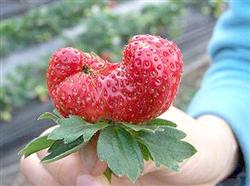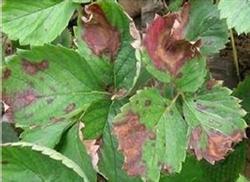Occurrence and control of abnormal strawberry fruit in greenhouse

In the process of strawberry planting in greenhouse, the fruit is often too fat or too thin, showing a chicken crown, flat and other abnormal shapes, this kind of fruit not only affects the quality of strawberry, but also reduces the commercial value, in order to reduce or even avoid the formation of this kind of abnormal fruit, the author introduces the causes and control methods as follows: first, the causes of abnormal fruit. 1. Breed difference. In general, varieties with shallow dormancy, strong cold tolerance and abundant and sound pollen, such as Fengxiang, Chunxiang and Baojiao early varieties, are less likely to form abnormal fruits. Strawberry plants will degenerate and senescence after 3-4 years of age, resulting in an increase in malformed fruit. two。 The room temperature is too low. The optimum temperature for the growth and development of strawberry is 20-25 ℃, and the lowest temperature during flowering and fruiting period should not be lower than 5 ℃. Too low temperature will seriously affect the growth and pollination of strawberry, and it is easy to produce abnormal fruit. 3. Spray at flowering stage. Anthesis spray can scour the stigma, especially the flowers blooming on the same day, which not only affects pollination, but also hinders or kills pollinating insects, resulting in an increase in the rate of abnormal fruit. 4. Light conditions. The formation of pollen begins about 2 weeks before flowering. During this period, if there is not enough light and overcast and rainy weather, it will inhibit the accumulation of starch needed for pollen germination, thus reducing the germination rate of pollen, which is not conducive to fertilization. 5. Cultivation and management. During the period of strawberry flower bud differentiation, if the fertilizer is insufficient or too much, and the nitrogen level in the seedlings is too low or too high, it will affect the quality of flower bud differentiation and is not conducive to normal pollination. During the period of flower bud differentiation, flowering and fruit expansion of strawberry, if there is not enough water, it will cause poor flower organ development, imperfect pollination and fertilization, fruit expansion and hindrance, and it is easy to form deformed fruit. Second, the prevention and control of deformed fruit. Control methods should not only select good varieties, especially some varieties with large amount of pollen in the main varieties, but also do a good job in the following points: 1. Promote the full differentiation of flower buds. The full differentiation of strawberry flower buds is an important factor affecting the yield and quality of strawberries in greenhouse. If the flower bud differentiation is good, the flower is more, the fruit is big and the abnormal fruit is less. Generally, root cutting, shading, nitrogen control and removal of old leaves began 2 weeks before planting in order to promote the full differentiation of flower buds. two。 Reasonable regulation of temperature and humidity. The flower organ of strawberry is sensitive to low temperature. if the low temperature is minus 2 ℃ for 1 hour, the pistil will turn black, so the heat preservation performance of the greenhouse should be improved. The greenhouse temperature should be kept at 20-25 ℃ during the day, 8-10 ℃ at night and 18-20 ℃ at night. The optimum humidity for strawberry anther dehiscence is 30-50%, and the optimum humidity for stigma fertilization and pollen germination is 50-60%. The closed environment in the greenhouse, not timely ventilation, will make the humidity too high, production can use no drip film, high ridge plastic film mulching cultivation, reduce soil water evaporation, short noon ventilation, in order to adjust the temperature and humidity. 3. Release bees at flowering stage. When the first batch of flower buds are formed, strawberries in the greenhouse can keep bees in the shed. 2-3 cases of bees are placed in each standard shed and placed evenly in the shed, so that the pollination rate can reach more than 95%. The bee-assisted pollination is used to reduce deformed fruit. 4. It is strictly forbidden to apply pesticides during flowering. The use of drugs during the flowering period of strawberry is strictly prohibited to prevent the abnormal fruit caused by reducing the germination rate of pollen. Therefore, the disease should be thoroughly prevented before flowering, and the diseased plant and inflorescence should be removed in time after flowering, so as to control the spread of the disease. 5. Timely thinning of flowers and fruits. Timely thinning of secondary flowers and malformed small fruits, diseased leaves, old leaves and yellow leaves is beneficial to increase light, reduce the rate of abnormal fruit, concentrate nutrient supply, and improve fruit weight and fruit quality. 6. Strengthen the management of fertilizer and water. The soil in the greenhouse is too dry, too wet, lack of fertilizer or improper fertilization, which will cause imbalance between water and nutrient supply and demand, resulting in poor fruit development and deformed fruit. The soil moisture is insufficient, should irrigate small water in time, if lack of fertilizer, should combine watering and topdressing fertilizer, should increase phosphorus and potassium fertilizer, do not apply ammonium bicarbonate, it is appropriate to use three-element compound fertilizer, about 15 kg per mu, after hydration, the effect of hole topdressing is better, soil moisture is insufficient after fertilization, timely watering, water to promote fertilizer, to meet the needs of normal flowering and fruit of strawberries, to prevent the production of abnormal fruit.
- Prev

How to make up for strawberry nitrogen deficiency in greenhouse?
Generally, at the beginning of nitrogen deficiency, the leaves in the peak growth period gradually changed from green to light green, and with the aggravation of nitrogen deficiency, the leaves became yellow, partially scorched and slightly smaller than normal leaves. With the aggravation of nitrogen deficiency, the young leaves became greener. The petiole and calyx of the old leaves are reddish, and the leaves are light or serrated bright red.
- Next

Control measures of Strawberry Diseases in greenhouse
Strawberry leaf blight is mainly harmful to petiole, fruit pedicel and calyx. 1. Symptoms. At the initial stage of the disease, dark purple-brown dull spots appeared on the leaves, then expanded into irregular spots, and the color of the edge and center of the spot changed little, so it was difficult to distinguish the symptoms of this disease from that of brown spot. Brown spot and leaf blight.
Related
- Moge, come on! The staff of the peasant association in the producing area of cantaloupe were frightened when the crowd gathered.
- Causes and Solutions of low Fruit setting rate of Apple
- Symptoms and control measures of passion fruit virus disease
- Fruit growing lesson: how do apple orchards keep high yields?
- Can you build orchards in the mountains? What are the pros and cons?
- How to manage the coloring period of Crisson grape?
- This paper introduces the processing technology of two kinds of fig products.
- How much is a month for retired teachers in rural areas by 2020?
- How can strawberry planting increase sugar content? We should pay attention to management in many aspects.
- What are the cultivation techniques on how to improve the yield of golden fruit?

